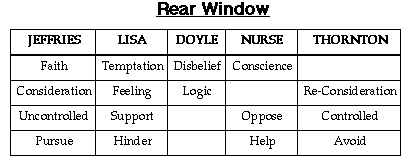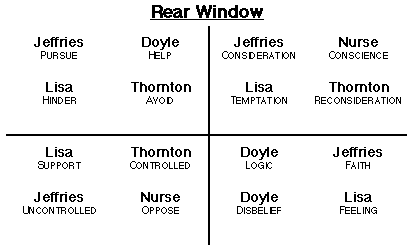From the Dramatica Theory Book:
Simply “Gone With The Wind”
As an exercise, let’s take a look at how the Motivation characteristics are represented and combined in some familiar well-written stories. Why don’t we tackle something simple like Gone With the Wind.
“Simple?” you say. In terms of thematics, Gone With the Wind is an extremely rich and complex story. But in terms of the characters, GWTW is no more complex than any of the other stories we have analyzed so far. Let’s see how.
Scarlett and Rhett
A list of the most notable Characters might include: Scarlett O’Hara, Rhett Butler, Ashley Wilkes, Melanie Wilkes, Scarlett’s sister Suellen, Frank Kennedy, Scarlett’s father Gerald O’Hara, and Prissy. Taking them one at a time, we can see the stuff they are made of.
Intuitively, we sense that Scarlett and Rhett are the two most important characters. Looking at the 16 characteristics, Scarlett is clearly Pursue. She pursues Rhett, she pursues Ashley, she pursues the tax money, she pursues a fortune. She is motivated to get people to consider things they normally would not. Based on this analysis we will call Scarlett PURSUE and CONSIDERATION.
Rhett, on the other hand, spends most of his time avoiding. He avoids getting involved in the war, and by his contraband dealings he avoids financial hardship. He avoids Scarlett’s advances, avoids the firing squad, avoids paying her the tax money, and on and on. Nonetheless, it is Rhett that continually urges Scarlett (and everyone else) to reconsider their actions. So Rhett comes down as AVOID and RECONSIDERATION.
Comparing Scarlett to Rhett, each contains one action characteristic and one decision characteristic. Solely in terms of Motivations, Scarlett and Rhett are Archetypal Protagonist and Antagonist.
Melanie and Ashley
There is little to disguise Ashley’s effect as TEMPTATION upon Scarlett. Just because he never actively tempts her does not diminish his actual temptation value. And this is a good point to file away for later: A character does not have to actively or even consciously employ a characteristic to represent it.
Looking for Ashley’s physical characteristic, although it is not strongly drawn, we find him to be HINDER. Now since his physical self is designed to be the source of Scarlett’s temptation, Hinder has been down-played to make him more attractive. Nevertheless, he repeatedly jeopardizes Scarlett’s situation. Temptation and Hinder make Ashley a Contagonist.
Melanie, in complement to Ashley, is CONSCIENCE and HELP. She continually tutors Scarlett in the “correct” morality, simultaneously cleaning up the real world messes that Scarlett leaves in her wake. Melanie is forever smoothing ruffled feathers and it is she who handles the hiding of the Yankee renegade soldier that Scarlett shoots. Conscience and Help make Melanie the Guardian.
It is interesting to note the Character pairings designed into this story. Scarlett (Pursue and Consideration) is paired with Rhett (Avoid and Reconsideration). Ashley (Temptation and Hinder) is paired with Melanie (Conscience and Help). Obviously, Margaret Mitchell had an amazingly intuitive sense of where the dramatic potentials lie. (But then, we knew that already, didn’t we?) Let’s see if this pattern continues.
Frank Kennedy, Suellen O’Hara, Gerald O’Hara, and Prissy
Scarlett’s screaming sister Suellen plays nicely as FEELING and UNCONTROLLED, making her the Emotion Character. Her choice of husband, Frank Kennedy (who is snatched by Scarlett) is again, an opposite. Kennedy, by virtue of his steadfast business development and religion of practicality defines LOGIC. And also by virtue of his steadfast business development and resistance to diverging from his plans demonstrates that he represents CONTROL (restraint). Kennedy fits nicely as the Reason Character, again, in a complementary posture to his intended bride.
Finally, we reach a most telling pair. First, we perceive Scarlett’s father Gerald O’Hara has FAITH. He believes that a war will never happen, then believes the South will win. Even when they have already lost he won’t give up his faith. He goes into a fantasy world rather than admit his faith is in error. On the flip side, he constantly OPPOSES Scarlett’s wishes. In the opening scene, Scarlett wants love but her father is pushing real estate. After the fall, he keeps jumping in with inane comments about the way Scarlett is handling the house. Consistently (albeit gently) he opposes her.
Prissy, on the other hand, has no faith at all. She is absolutely convinced that no matter what the situation, the worst will happen. She is a DISBELIEVER pure and true. And yet, she SUPPORTS Scarlett in every self-serving endeavor she instigates. As with other characters we have examined, Mr. O’Hara and Prissy have swapped characteristics, this time between the Skeptic and Sidekick. They are a complementary pair. This is a wonderful twist from a thematic standpoint, pairing and swapping characteristics between a rich white landholder and a poor black slave.





